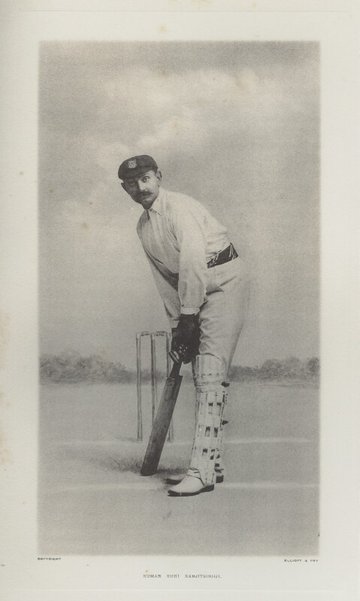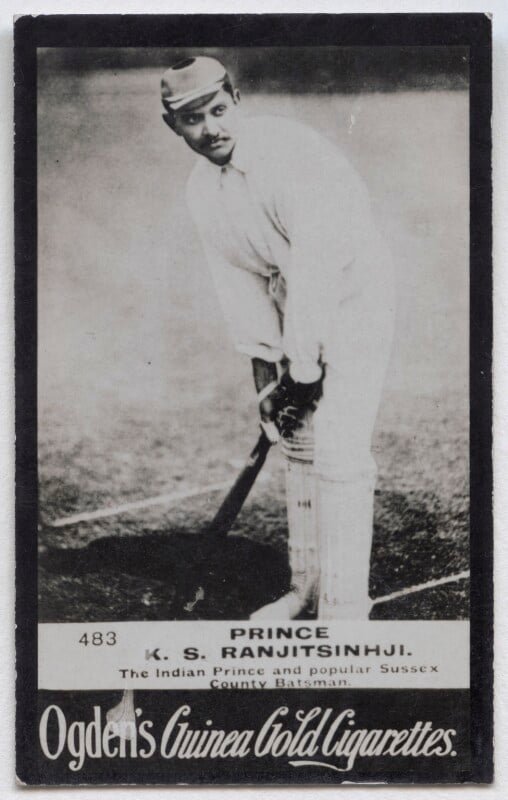
Kumar Shri Ranjitsinhji
‐
Prince of Nawanagar who was the first South Asian to play for the England cricket team in 1896
Other names
Ranji
Place of birth
Date of arrival to Britain
Location(s)
TW18 4NX
United Kingdom Sussex Cricket Club
BN3 3AN
United Kingdom Trinity College, Cambridge
CB2 1TQ
United Kingdom
Place of death
Jamnagar, India
Date of time spent in Britain
1888–1904, 1908, 1912, 1915, 1920
About
Kumar Shri Ranjitsinhji was a cricketer for England and a Prince of Nawanagar State in India, known as 'Ranji' to his cricketing fans. As a child, he was chosen as heir to a distant relative, Vibhaji, the Jam Sahib of Navanagar, but then discarded. He studied at the Rajkumar College in Rajkot and then in 1888, aged 16, Ranjitsinhji went to Britain. He joined Trinity College, Cambridge in 1889. It was not until 1893, having played in the meantime for local clubs on Parker's Piece, that Ranji gained a place in the Cambridge University cricket team. He was the first Indian to win a cricket blue. In 1895 Ranji began to play regularly for Sussex. Having faced opposition to his inclusion in the university side, there was now a growing public debate as to whether Ranji should be allowed to play for the England national side. In 1896 Ranji made his debut for England against Australia at Old Trafford. In 1897 Ranjitsinhji produced a book on the evolution of cricket in England called The Jubilee Book of Cricket. In the winter of 1897–8, Ranji toured Australia with the England team.
In 1904 Ranji returned to India as he was no longer playing for England and could not financially support himself in Britain. However, he continued to return to England at regular intervals and play for Sussex. In 1906 the new Jam Sahib of Navanagar, the son of Vibhaji, died and, there being no other formal heir, Ranjitsinhji assumed the throne. When war broke out in 1914, Ranji helped the imperial effort by converting his house in Staines into a hospital for wounded soldiers, donating troops from Navanagar and going to the Western Front himself. Ranji also had a lakeside castle at Ballynahinch, on the west coast of Ireland. In August 1915 he lost his right eye in a shooting accident in Yorkshire, and he played his last game for Sussex in 1920. As an Indian prince, Ranjitsinhji took on many political responsibilities: he represented India twice at the League of Nations and was a delegate to the Round Table Conference sessions in 1930. He died in 1933 in one of his palaces in Jamnagar.
Duleepsinhji (nephew who also played cricket for England), C. B. Fry (friend and Sussex team mate), Lord Hawke (fellow cricketer), Madge Holmes (neighbours initially in Sidney Street, Cambridge: Ranji corresponds with Madge, 1891–1905).
The Jubilee Book of Cricket (Edinburgh: Thomas Nelson, 1897)
With Stoddart's Team in Australia (London: Constable & Co., 1898)
Graeme, Margaret, Ranji's A'Comin! (London: Horsham, Price & Co., 1903)
Guha, Ramachandra, A Corner of a Foreign Field: The Indian History of a British Sport (London: Picador, 2002)
Raiji, Vasant, Ranji: The Legend and the Man (Bombay: Vasant Raiji, 1963)
Rodrigues, Mario, Batting for Empire: A Political Biography of Ranjitsinhji (Delhi: Penguin, 2003)
Ross, Alan, Ranji: Prince of Cricketers (London: Collins, 1983)
Sen, Satadru, Migrant Races: Empire, Identity and K. S. Ranjitsinhji (Manchester: Manchester University Press, 2004)
Wild, Roland, The Biography of Colonel His Highness Shri Sir Ranjitsinhji (London: Rich & Cowan, 1934)
Wilde, Simon, Ranji: A Genius Rich and Strange (London: Kingswood, 1990)
Wilde, Simon, ‘Ranjitsinhji Vibhaji, Maharaja Jam Sahib of Navanagar [Ranjitsinhji or Ranji] (1872–1933)’, Oxford Dictionary of National Biography (Oxford University Press, 2004) [http://www.oxforddnb.com/view/article/35190]
Film footage, British Film Institute, London
Crown Representative Records, Asian and African Studies Reading Room, British Library, St Pancras
Correspondence with Lord Hardinge, Cambridge University Library
School Records, Rajkot, India
Letters to Madge Holmes, Wren Library, Trinity College, Cambridge
For image and copyright details, please click "More Information" in the Viewer.

Ranjitsinhji ('Ranji') Vibhaji, Maharaja Jam Sahib of Navanagar by (Karl Anton) Reinhold Thiele, published by Ogden's cigarette card, published circa 1901, NPG x136683
© National Portrait Gallery, London, Creative Commons, http://creativecommons.org/licenses/by-nc-nd/3.0/
Image credit
Ranjitsinhji ('Ranji') Vibhaji, Maharaja Jam Sahib of Navanagar, by Ernest Clarence Elliott, for Elliott & Fry, collotype, published 1904, NPG Ax39987
© National Portrait Gallery, London, Creative Commons, https://creativecommons.org/licenses/by-nc-nd/3.0/
